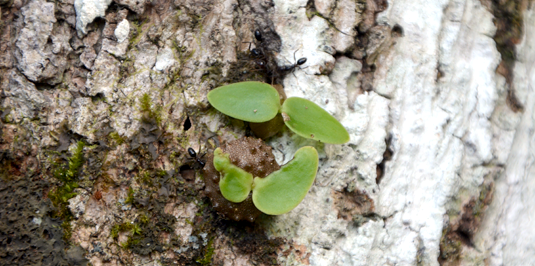Farming Timeline: Ants Were Growing Food Long Before Humans

It is generally understood that human society turned to agriculture about 10,500 years ago in the region that is the Middle East today, and that turn in the human way of life set us down the path to modern civilization. Now, researchers have found another species that is not nearly as technologically advanced as we are but has been practicing agriculture for millions of years longer.
Philidris nagasau, an ant species in Fiji has been cultivating at least six species of a plant genus Squamellaria, for over 3 million years, a recent study by researchers from Ludwig-Maximilians-University (LMU) of Munich, Germany, found. While another ant species has been known to farm fungus for much longer — about 8 million years — this is the first time an insect species have been found to be growing plants.
Published under the title “Obligate plant farming by a specialized ant” in the journal Nature Plants, the study reports “a novel type of ant–plant symbiosis in Fiji where one ant species actively and exclusively plants the seeds and fertilizes the seedlings of six species of Squamellaria.”
So how exactly do these tiny insects carry out their farming? For that, we first need to know that the Squamellaria plant grows in the nooks and crannies of branches of other trees.
“The plants colonize three or four tree species, which are also attractive for the ants, either because they produce readily accessible nectar, or because their bark is particularly soft, so that the ants can easily widen the cracks that form,” Susanne Renner, LMU botany professor and study co-author, explains in a statement.
P. nagasau carry seeds to these cracks and deposit them there for growth, and to provide nourishment to the seedlings, they add their own excreta as manure to fertilize the plant. The plant itself grows like a colony of hollow tubes, ideal for the ants to live in and form large colonies. These colonies are home to several protected nests for the ants and form something akin to a village.
Guillaume Chomicki, lead author of the study and PhD student at LMU, said in the statement: “One often finds dozens of colonies, connected by ant highways, on a single tree. All of these individuals are the progeny of a single queen, whose nest is located in the center of the system.”
The researchers found that neither the plant species nor the ants can survive without this interdependence. They also analyzed homologous DNA sequences in both the plants and the ants to conclude that the symbiotic relationship began about 3 million years ago.
© Copyright IBTimes 2024. All rights reserved.







